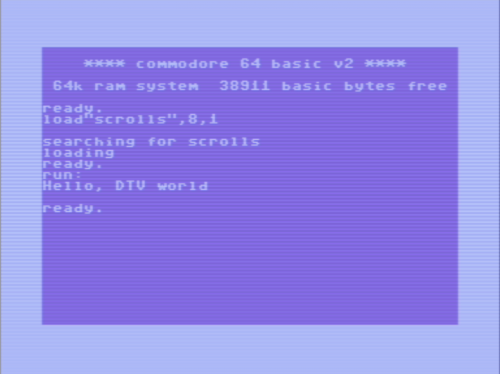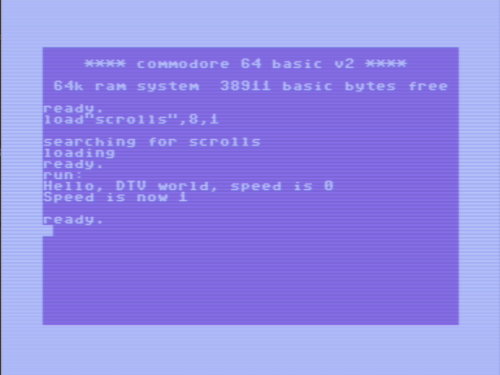This is an old revision of the document!
DTV (and C64) Programming - Using the CC65 toolchain
Basic use of CC65
CC65 Options for the C64 / DTV
- You can compile, assemble and link in one pass using cl65, but when using multiple source files you must use cc65, then as65, then ld65.
- There is no distinct target for the DTV, use the CC65 target flag '-t c64'
- Compiler optimisation is enabled by '-O', maximum optimisation is achieved by '-Oirs'
- The C64 runtime needs to be linked against 'c64.lib', it should be the last command line argument to ld65.
Example Makefile
This example makefile uses CC65 to compile, assemble and then link our source code. It assumes the following about our project layout:
- Source code is stored in ./src/
- Intermediary assembler and object files are created in ./bin/
- Fully linked programme output is copied into ./dist/
- The Vice x64dtv emulator is installed to run the resulting file(s).
Extend the OBJFILES value with any additional code that needs compiling, and add a stanza to match the bin/main.o entry for each. A macro to glob src/*.c would be an improvement, especially if compiling many different source files.
################################# # Path to tools ################################# CC = cc65 AS = ca65 LD = ld65 VICE = x64dtv RM = rm RMFLAGS = -f -v ################################# # Compiler flags ################################# LIB = SYSTEM = dtv EXTRA_INCLUDES = -I./src -I./common CFLAGS = -Oirs -t c64 CFLAGS_DEBUG = -Oirs -t c64 -D DEBUG=1 ASFLAGS = -t c64 LDFLAGS = -t c64 EXTRA_LIBS = c64.lib LIBRARY_PATH = ################################# # What our application is named ################################# TARGET_NAME = scrolls.prg TARGET = bin/$(TARGET_NAME) ################################# # Targets to build/run ################################# all: $(TARGET) full: all run: all copy doit ################################# # List of all needed game object files ################################# OBJFILES = bin/main.o ########################################################### # This builds our game binary from the defined OBJFILES ########################################################### $(TARGET): $(OBJFILES) @echo "" @echo "========================================" @echo " -= Linking $(TARGET) =-" @echo "" @echo Linking main binary.... $(LD) $(LDFLAGS) $(LIBRARY_PATH) -o $(TARGET) $(OBJFILES) $(EXTRA_LIBS) @echo "======= END OF $(TARGET) ===============" @echo "" @echo "" ####################################### # C sections ####################################### #### Main #### bin/main.o: src/main_dtv.c $(CC) $(CFLAGS) $(EXTRA_INCLUDES) src/main_dtv.c -o bin/main.s $(AS) $(ASFLAGS) bin/main.s -o bin/main.o ############################### # Copy in game assets ############################### copy: @echo "" @echo "==========================" @echo " Copying game assets" @echo "" @echo "- Copying files..." rm -rf dist/* mkdir -p dist/assets cp -v $(TARGET) dist/ @echo "" @echo "==========================" ############################### # Run binary ############################### doit: @echo "" @echo "==========================" @echo " Running game" @echo "" cd dist && $(VICE) -autostart $(TARGET_NAME) ; cd - ############################### # Clean up ############################### clean: @echo "" @echo "==========================" @echo " Cleaning up" @echo "" @echo "- Old object files..." rm -rf bin/* rm -rf dist/* @echo "" @echo "=========================="
Accessing DTV Features
The C64 DTV is a very close re-implementation of the C64 (it is not a 100% accurate implementation, but fairly close), but it also has a substantial number of improvements over the original system:
- 2MB RAM
- Blitter
- Faster memory/processor
- New video modes
- Digital 8bit sound
Some of these are exposed directly in CC65, whereas some need to be enabled/toggled via writing to various addresses in memory.
Basic DTV Functions
Detecting DTV
#include <accelerator.h> unsigned char detect_c64dtv(void);
Returns 1 if the code is running on a C64 DTV2/3. Otherwise returns 0.
#include <stdio.h> #include <accelerator.h> int main(){ if (detect_c64dtv()){ printf("Hello, DTV world\n"); } else { printf("Hello, C64 world\n"); } return 0; }
Output:
Get/Set DTV CPU Speed
#include <accelerator.h> unsigned char get_c64dtv_speed(void); unsigned char __fastcall__ set_c64dtv_speed(unsigned char speed);
The DTV can (optionally) run faster than the normal C64. It has two speeds 0 (SPEED_SLOW / SPEED_1X) and 1 (SPEED_2X).
#include <stdio.h> #include <accelerator.h> int main(){ unsigned char s; if (detect_c64dtv()){ s = get_c64dtv_speed(); printf("Hello, DTV world, speed is %d\n", s); s = set_c64dtv_speed(SPEED_2X); printf("Speed is now %d\n", s); } else { printf("Hello, C64 world\n"); } return 0; }
Output
Enabling 320x200 Linear Framebuffer
One of the main party tricks of the DTV is that it has support for a 320×200, 8bpp (256 colour) screen mode. But this takes up more memory (64000 bytes) than is available in the remainder of the CPU-accessible working RAM of the computer. Hence the framebuffer needs to be created in the memory region of 64kb-2048kb, known as extended/high memory.
Here's a set of simple functions and prototypes that initialise the DTV hardware and set up access to a 320×200, 8bpp linear framebuffer at 0x0100000. The location of the framebuffer in extended memory is controlled by the value of FRAMEBUFFER_0:
dtv_Init()
#include <stdint.h> #include <accelerator.h> #include "dtv.h" #include "dtv_reg.h" void dtv_Init(void){ unsigned char i; // ================================================= // Initialise extended functions of DTV // ================================================= POKE(DTV_VIC_REG_EXTENDED, 0x01); // Enabled extended VIC features // ================================================= // Enable DTV 2X speed // ================================================= set_c64dtv_speed(SPEED_2X); // ===================================== // Set up the linear framebuffer and 8bpp chunky pixel mode // ===================================== POKE(DTV_VIC_REG_CFG, 0x55); // Enable linear framebuffer mode POKE(DTV_VIC_REG_CONTROL_1, 0x5B); // POKE(DTV_VIC_REG_CONTROL_2, 0x18); // POKE(DTV_VIC_REG_BORDER, 0); // Border colour to black POKE(DTV_VIC_REG_BG_0, 0); // BG colour to black POKE(DTV_VIC_REG_LFB_STEPSIZE, 0x08); // Set step size of 8 == 8bpp // ===================================== // Set framebuffer address // ===================================== POKE(DTV_VIC_REG_LFB_START_LOW, FRAMEBUFFER_0); POKE(DTV_VIC_REG_LFB_START_MED, FRAMEBUFFER_0 >> 8); POKE(DTV_VIC_REG_LFB_START_HI, FRAMEBUFFER_0 >> 16); // ========================================= // Set the first 16 palette entries to // be part of the full 256 colours, and not // the standard C64 set. // ========================================= for(i = 0; i < 16; i++){ POKE(DTV_VIC_PALETTE + i, i); } }
dtv.h
#ifndef _DTV_H #define _DTV_H #include <stdint.h> // These are simple macros to emulate BASIC peek/poke or the inb/outb of other platforms #define POKE(addr,val) (*(unsigned char*) (addr) = (val)) #define PEEK(addr) (*(unsigned char*) (addr)) #define DMA_COMPLETE 1 #define DMA_IN_PROGRESS 0 #define DMA_RAM_MASK 0x400000 // Mask to apply to addresses when the address is of RAM #define DMA_ROM_MASK 0x000000 // Mask to apply to addresses when the address is of ROM #define FRAMEBUFFER_0 0x010000 // Where the 64k linear framebuffer is located in high memory #define FRAMEBUFFER_1 0x020000 // Our 64k drawing pad that gets flipped to framebuffer 0 #define FRAMEBUFFER_SIZE 320 * 200 // DMA functions void dtv_dma(uint32_t src, uint32_t dst, uint16_t size); // Generic void dtv_Init(void); #endif <code C>
dtv_reg.h
// DTV registers which can toggle extended features on/off #define DTV_VIC_REG_CONTROL_1 0xD011 #define DTV_VIC_REG_CONTROL_2 0xD016 #define DTV_VIC_REG_BORDER 0xD020 // Border pen colour #define DTV_VIC_REG_BG_0 0xD021 // BG pen colour #define DTV_VIC_REG_CFG 0xD03C // Controls linear framebuffer mode amongst other settings #define DTV_VIC_REG_EXTENDED 0xD03F // Enables/disabled DTV extended feature set #define DTV_VIC_REG_LFB_START_LOW 0xD049 // Linear framebuffer address low byte #define DTV_VIC_REG_LFB_START_MED 0xD04A // Linear framebuffer address middle byte #define DTV_VIC_REG_LFB_START_HI 0xD04B // Linear framebuffer address high byte #define DTV_VIC_REG_LFB_STEPSIZE 0xD04C // Linear framebuffer chunk size, 8 == 8bpp #define DTV_VIC_PALETTE 0xD200 // Start address of palette entries #define DMA_PORT_SOURCE_LOW 0xD300 // DMA transfer source address low byte #define DMA_PORT_SOURCE_MED 0xD301 // DMA transfer source address middle byte #define DMA_PORT_SOURCE_HI 0xD302 // DMA transfer source address high byte #define DMA_PORT_DEST_LOW 0xD303 // DMA transfer destination address low byte #define DMA_PORT_DEST_MED 0xD304 // DMA transfer destination address middle byte #define DMA_PORT_DEST_HI 0xD305 // DMA transfer destination address high byte #define DMA_PORT_SOURCE_STEP_LOW 0xD306 // DMA transfer step size low byte #define DMA_PORT_SOURCE_STEP_HI 0xD307 // DMA transfer step size high byte #define DMA_PORT_DEST_STEP_LOW 0xD308 // DMA transfer step size low byte #define DMA_PORT_DEST_STEP_HI 0xD309 // DMA transfer step size high byte #define DMA_PORT_SIZE_LOW 0xD30A // DMA transfer length low byte #define DMA_PORT_SIZE_HI 0xD30B // DMA transfer length high byte #define DMA_PORT_STATUS 0xD31F // DMA status & control register
Double Buffering & DMA Copies
To access the extended memory area you can use several techniques, the easiest is to engage the DMA controller to shift blocks of memory between regions. The controller works with a source and destination address and the length of the transfer (in bytes).
The transfer can go from the 0-64kb region to the 64-2048kb region and even from ROM to RAM. The function below is hard coded to transfer RAM to RAM (note the bitmask applied to the source and destination addresses) by setting the upper 2 bits of the high byte of both source and destination.
The address format is as follows:
- Bits 0-7: Low byte (8 bits)
- Bits 8-15: Middle byte (8 bits)
- Bits 16-21: High byte (6 bits)
- Bits 22-23: Address type (2 bits)
The meaning of those two address bits are:
- 00: Address is ROM
- 01: Address is RAM
- 10: Address is RAM + Register (??)
So, OR your addresses with 0x400000 for RAM source/destinations, or leave them unmasked to indicate ROM sources (you probably know what you're doing if you're doing a DMA copy from ROM…):
dtv_dma
#include <stdint.h> #include <accelerator.h> #include "dtv.h" #include "dtv_reg.h" void dtv_dma(uint32_t src, uint32_t dst, uint16_t size){ // Copy 'size' bytes of data from 'src' to 'dst' in high memory // using the DMA engine. // 'src' and 'dst' are the addresses to copy from - they are NOT pointers uint32_t src_masked; uint32_t dst_masked; // Source and destination addresses need to be OR-ed with a RAM/ROM // mask in order for the DMA controller to recognise that these are in // RAM, and not ROM. src_masked = src | DMA_RAM_MASK; dst_masked = dst | DMA_RAM_MASK; // Wait for any previous DMA to complete while (PEEK(DMA_PORT_STATUS) & 0x01){}; // Set source low/medium/high bytes POKE(DMA_PORT_SOURCE_LOW, src_masked); POKE(DMA_PORT_SOURCE_MED, src_masked >> 8); POKE(DMA_PORT_SOURCE_HI, src_masked >> 16); // Set destination low/medium/high bytes POKE(DMA_PORT_DEST_LOW, dst_masked); POKE(DMA_PORT_DEST_MED, dst_masked >> 8); POKE(DMA_PORT_DEST_HI, dst_masked >> 16); // Set size of transfer in bytes POKE(DMA_PORT_SIZE_LOW, size); POKE(DMA_PORT_SIZE_HI, size >> 8); // Start the transfer POKE(DMA_PORT_STATUS, 0x0D); }
Here are a couple of functions which fill an off-screen scratchpad with a solid colour, and then copies the entire 320×200 scratchpad to the linear framebuffer using the dtv_dma() function above:
#include <stdio.h> #include <string.h> #include "dtv.h" void draw_Clear(void){ // Clear the contents of the screen buffer with a solid colour unsigned char i; char blit_buffer[320]; // Fill the blit buffer with 320px worth of black pixels memset(blit_buffer, 0x00, 320); // Copy SCREEN_HEIGHT worth of blit_buffers to the screen buffer for (i = 0; i < 200; i++){ dtv_dma((uint32_t*)&blit_buffer, FRAMEBUFFER_1 + (i * 320), 320); } } void draw_Flip(void){ // Flip the screen buffer to the linear framebuffer in one operation dtv_dma(FRAMEBUFFER_1, FRAMEBUFFER_0, (uint16_t) FRAMEBUFFER_SIZE); }

